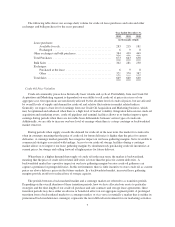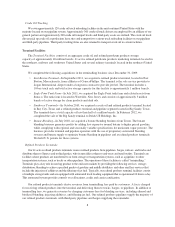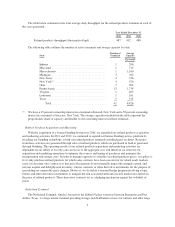Sunoco 2012 Annual Report Download - page 19
Download and view the complete annual report
Please find page 19 of the 2012 Sunoco annual report below. You can navigate through the pages in the report by either clicking on the pages listed below, or by using the keyword search tool below to find specific information within the annual report.result of these regulations, our customers could be required to make significant capital expenditures, operate
refineries at reduced levels, and pay significant penalties. It is uncertain what our customers’ responses to these
emerging issues will be. Those responses could reduce throughput in our pipelines and terminals, cash flow, and
our ability to make distributions or satisfy debt obligations.
Hazardous Substances and Waste
In the course of ordinary operations, we may generate waste that falls within the Comprehensive
Environmental Response, Compensation, and Liability Act’s, referred to as CERCLA and also known as
Superfund, definition of a “hazardous substance” and, as a result, may be jointly and severally liable under
CERCLA for all or part of the costs required to clean up sites at which these hazardous substances have been
released into the environment. Costs for any such remedial actions, as well as any related claims, could have a
material adverse effect on our maintenance capital expenditures and operating expenses to the extent not all are
covered by the indemnity from Sunoco. For more information, please see “Environmental Remediation.”
We also generate solid wastes, including hazardous wastes that are subject to the requirements of the
Federal Resource Conservation and Recovery Act, referred to as RCRA, and comparable state statutes. We are
not currently required to comply with a substantial portion of the RCRA requirements because our operations
generate minimal quantities of hazardous wastes. However, it is possible that additional wastes, which could
include wastes currently generated during our operating activities, will in the future be designated as “hazardous
wastes.” Hazardous wastes are subject to more rigorous and costly disposal requirements than non-hazardous
wastes. Any changes in the regulations could have a material adverse effect on our maintenance capital
expenditures and operating expenses.
We currently own or lease properties where hydrocarbons are being or have been handled for many years.
These properties and wastes disposed thereon may be subject to CERCLA, RCRA, and comparable state laws.
Under these laws, we could be required to remove or remediate previously disposed wastes (including wastes
disposed of or released by prior owners or operators), to clean up contaminated property (including contaminated
groundwater), or to perform remedial operations to prevent future contamination.
We have not been identified by any state or federal agency as a potentially responsible party in connection
with the transport and/or disposal of any waste products to third-party disposal sites.
Water
Our operations can result in the discharge of regulated substances, including crude oil or refined products.
The Federal Water Pollution Control Act of 1972, also known as the Clean Water Act, and comparable state laws
impose restrictions and strict controls regarding the discharge of regulated substances into state waters or waters
of the United States. Where applicable, our facilities have the required discharge permits.
The Oil Pollution Act subjects owners of covered facilities to strict joint and potentially unlimited liability
for removal costs and other consequences of a release of oil, where the release is into navigable waters, along
shorelines or in the exclusive economic zone of the United States. Spill prevention control and countermeasure
requirements of the Clean Water Act and some state laws require that containment dikes and similar structures be
installed to help prevent the impact on navigable waters in the event of a release. The Office of Pipeline Safety of
the DOT, the EPA, or various state regulatory agencies, has approved our oil spill emergency response plans, and
our management believes we are in substantial compliance with these laws.
In addition, some states maintain groundwater protection programs that require permits for discharges or
operations that may impact groundwater conditions. Our management believes that compliance with existing
permits and compliance with foreseeable new permit requirements will not have a material adverse effect on our
results of operations, financial position or expected cash flows.
17
























